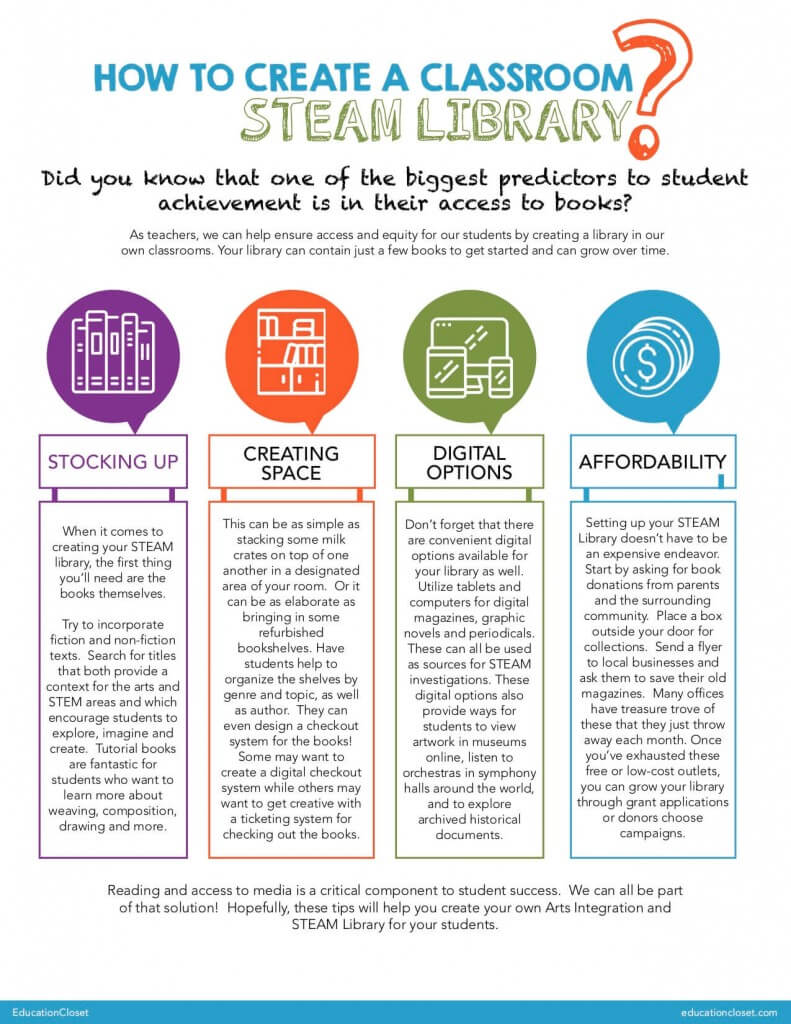How to Create a Classroom STEAM Library
3 Min Read • Classroom Setup
Did you know that one of the biggest predictors to student achievement is in their access to books? It’s a sad reality that some schools have wonderful libraries and media centers, while others barely have enough textbooks to go around. As teachers, we can help ensure access and equity for our students by creating a library in our own classrooms. And what better avenue to encourage integrating the arts than through a classroom STEAM library?
This doesn’t have to be difficult or overly robust to be effective. Your library can contain just a few books to get started and can grow over time. Even a little nook in a corner of your room, or a bin on a cart will work. The idea is to have a dedicated space for the books and for all students to have access to them.
Stocking Up
When it comes to creating your classroom STEAM library, the first thing you’ll need are the books themselves. We’ve suggested many different titles in the past, from Arts Integration books to STEAM books to Picture Books. Any and all of these would be a great start. Even at the middle and high school grades, picture books can be effective and can be used for developing observational skills.
Try to incorporate fiction and non-fiction texts. Search for titles that both provide a context for the arts and STEM areas and which encourage students to explore, imagine and create. Tutorial books are fantastic for students who want to learn more about weaving, composition, drawing and more. You’ll want to also connect with your arts teachers or content area teachers for book recommendations.
Creating Space
Once you have your books picked out, you’ll want to design a space for the library to reside. This can be as simple as stacking some milk crates on top of one another in a designated area of your room. Or it can be as elaborate as bringing in some refurbished bookshelves.
Once you’ve set aside the space, have students help to organize the shelves by genre and topic, as well as author. The more students are invested in this process, the more they will respect the space. They can even design a checkout system for the books!
Some may want to create a digital checkout system while others may want to get creative with a ticketing system for checking out the books. Use this as an opportunity for students to problem solve and organize their own systems.
Digital Options
Don’t forget that there are convenient digital options available for your library as well. Utilize tablets and computers for digital magazines, graphic novels and periodicals. These can all be used as sources for STEAM investigations.
These digital options also provide ways for students to view artwork in museums online, listen to orchestras in symphony halls around the world, and to explore archived historical documents.
Affordability
Setting up your classroom STEAM Library doesn’t have to be an expensive endeavor. Start by asking for book donations from parents and the surrounding community. Place a box outside your door for collections. Send a flyer to local businesses and ask them to save their old magazines. Many offices have treasure trove of these that they just throw away each month.
Goodwill and yard sales offer a great way to pick up some excellent books at very low prices. And if you have any books at home that are going unused, bring those in as well. The NEA has an excellent resource on how to find free books online and in your community. These include print, as well as audiobooks, videos and digital copies.
Once you’ve exhausted these free or low-cost outlets, you can grow your library through grant applications or donors choose campaigns.
Reading and access to media is a critical component to student success. We can all be part of that solution! Hopefully, these tips will help you create your own Arts Integration and STEAM Library for your students.




